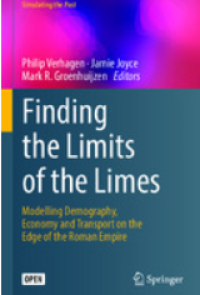
Text
E-book Finding the Limits of the Limes : Modelling Demography, Economy and Transport on the Edge of the Roman Empire
Penilaian
0,0
dari 5The Dutch limes zone roughly comprises a 50 km wide strip in the middle of the Netherlands, stretching from the North Sea until Germany over a distance of approximately 150 km from west to east. To the north, the zone is bordered by the course of the Rhine, which was established as the northern frontier of the Roman Empire around the middle of the first century CE. The Romans never clearly demar-cated the geographical extent of the limes, but it may have meant as much as a zone of hundreds of kilometres wide (Whittaker 1997). For all practical purposes, how-ever, the Dutch ‘limes zone’ can be defined as the extent of the two civitates, or allied states, of the Batavians and Cananefates immediately south of the Rhine. The exact extent of these civitates remains somewhat speculative, but it is thought that the Batavian civitas covered the zone roughly to the east of the current town of Woerden up into current Germany, and to the south it would have reached a few kilometres inland from the Meuse (Maas) river (Vossen 2003; Vos 2009). The Cananefatian civitas occupied the western half of the limes zone, roughly delimited to the south by the current provincial borders of Zuid-Holland (Fig. 1.1).This region has undergone considerable environmental and anthropogenic change over the past 2000 years, leading to substantial changes in river courses, coastline, vegetation and land use. The Rhine diverted its main branch to the south in the course of the Early Middle Ages, and the current coastline dates from the Late Medieval period. Peat reclamation in the Late Middle Ages and Early Modern period created the current polder landscape, and large-scale urbanization in the ineteenth and twentieth centuries further altered the rural landscape. All in all, the current region would be almost unrecognizable to the inhabitants of the Roman period. This means that no meaningful historical and archaeological analysis of the Dutch limes zone can be undertaken without a reconstruction of its palaeogeogra-phy. Fortunately, a palaeogeographical map of the north-western part of the limeszone was already assembled by Van Dinter (2013) on the basis of an extensive data-base of geological bore holes collected by the University of Utrecht, and of detailed LiDAR-based elevation data. We have followed her methodology to complete this reconstruction for the remaining area of the study region. A detailed description of the data sources used and the methodology applied is given in Groenhuijzen (2018)..
Ketersediaan
Informasi Detail
- Judul Seri
-
-
- No. Panggil
-
902 VER f
- Penerbit
- Switzerland : Springer Nature., 2019
- Deskripsi Fisik
-
339 hlm
- Bahasa
-
English
- ISBN/ISSN
-
9783030045760
- Klasifikasi
-
902
- Tipe Isi
-
text
- Tipe Media
-
computer
- Tipe Pembawa
-
online resource
- Edisi
-
-
- Subjek
- Info Detail Spesifik
-
-
- Pernyataan Tanggungjawab
-
-
Versi lain/terkait
Tidak tersedia versi lain
Lampiran Berkas
Komentar
Anda harus masuk sebelum memberikan komentar
 Karya Umum
Karya Umum  Filsafat
Filsafat  Agama
Agama  Ilmu-ilmu Sosial
Ilmu-ilmu Sosial  Bahasa
Bahasa  Ilmu-ilmu Murni
Ilmu-ilmu Murni  Ilmu-ilmu Terapan
Ilmu-ilmu Terapan  Kesenian, Hiburan, dan Olahraga
Kesenian, Hiburan, dan Olahraga  Kesusastraan
Kesusastraan  Geografi dan Sejarah
Geografi dan Sejarah